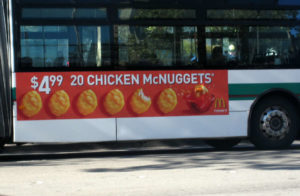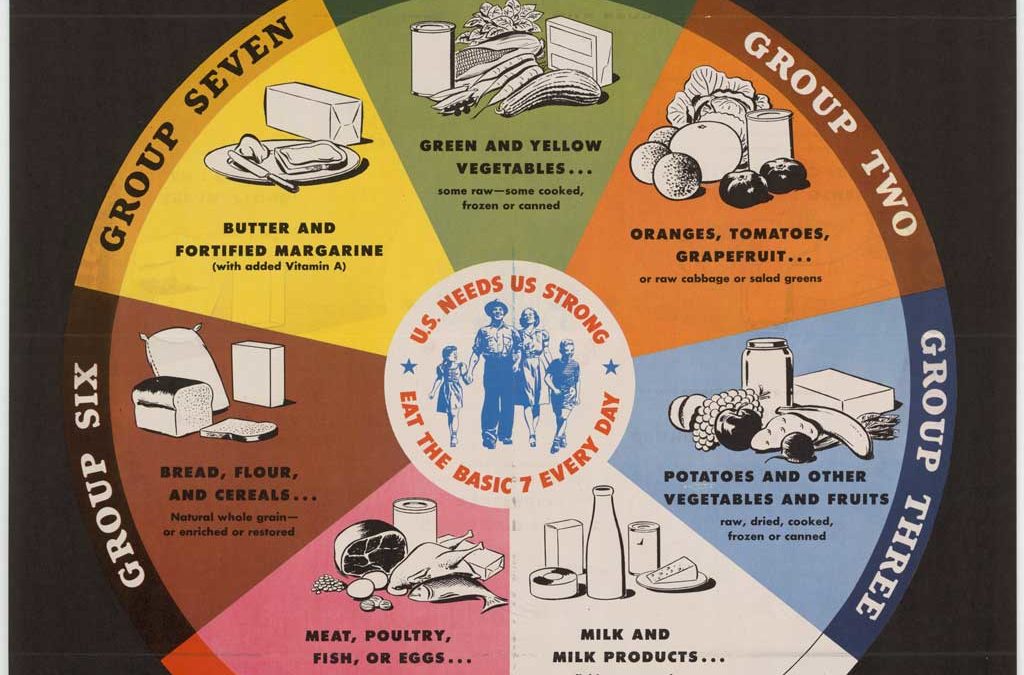“I didn’t know food was so political,” was my Dad’s comment after reading Michael Pollen’s In Defense of Food. Dad like the vast majority of people, ate when he was hungry. He was eating food long before the calories from fat or grams of sodium were found on food labels. Food for Dad was pure pleasure and of course, a necessity! Like my Dad, I ate what has put in front of me, and my diet included not only the wholesome foods my mother or I cooked, but also calorie-laden sweets and snacks, until my once upon a time skinny person metabolism changed. I now have to be much more mindful of what I put into my body, so I don’t become classified as overweight by today’s U.S. Department of Health Standards.
Unlike my Dad, eaters born since the advent of the television age are more readily trained on what and how to eat by food company advertising, journalism and the government. There are countless commercials on television, the internet, in the movies, on billboards, covering t-shirts, on race cars and buses and everything else you can imagine. There are daily articles in newspapers, blogs, radio broadcasts, and conversations with friends about what to eat or not to eat. Different parts of government, whether it is the US Department of Agriculture, the Food and Drug Administration, the local county government, or a classroom teacher provide information to willing listeners on food policy. No longer are we just eating the wholesome food of earlier generations but instead consuming foods, as Pollan says, our “great grandmother wouldn’t recognize as food.” Paying attention to the constant food babble on our meal choices is never-ending.
Typical Food Company Advertising

McDonald’s Bus Advertisement
An unrecognizable concoction in earlier generations now advertised on the sides of buses, are the ubiquitous Chicken McNuggets®–a breaded, processed chicken chunk–created by the giant food company McDonald’s. The chicken chunk does include the well-known fowl as its first ingredient, but also a myriad of other ingredients not found in my kitchen including “hydrogenated soybean oil with TBHQ” and “dimethylpolysiloxane.”
TBHQ also known as “tertiary butylhydroquinone” is a petroleum based preservative product added to edible vegetable and animal fats, to prevent spoilage. The US Food and Drug Administration (“FDA”) has legally limited the quantity of TBHQ to 0.02% of any product’s oil and fat content. According to A Consumer’s Dictionary of Food Additives, as little as a single gram (1/30th of an ounce) of TBHQ consumption, can cause “nausea, vomiting, ringing in the ears, delirium, a sense of suffocation, and collapse.”
The other mysterious ingredient is dimethylpolysiloxane, an anti-foaming agent similar to silicone products found in cosmetics and the childhood toy, Silly Putty. While no known harmful effects have been found from dimethylpolysiloxane’s use in foods, I’m sure my great grandmother did not add it to her cooking repertoire.
Food Journalism
Journalism has also added immensely to the politics of food. Newspapers have long included recipes and feature articles on food in the Wednesday paper with the inserts of the tantalizing, money saving coupons. Now discussions on food issues are just as likely to show up on the front page of the paper or have dedicated websites such as Food Safety News.
Newspapers chronicled the late 1980’s rise and quick decline of oat bran as a health fad to lower cholesterol levels. In 1993, it was Jack in the Box’s turn where under-cooked, fecal-infested, hamburgers were served with four children’s lives lost. Beginning in 2001, there have been compromised honey imports into the United States from China via other countries. Now in the honey scandal, people have been charged, fines have been paid, and the saga continues to this day. [I know I can trust my local honey producer Snoqualmie Valley Honey Farm.] There is the continued diet craze where recommendations on what to eat and how much to eat are made. There is the Atkins Diet, Weight Watchers, DASH, and numerous other diet programs to consider and evaluate.
Journalism is invested in keeping us well-informed, aware, and perhaps sometimes afraid about what we ingest.
Government’s Food Policies
Our U.S., state, and local governments also dispense a stupendous wealth of food information. The Center for Disease Control, local health departments, and schools are working to implement wellness programs and physical activity guidelines to reign in the obesity epidemic. The Farm Bill authorized by Congress approximately every five years, impacts rural farming communities, international trade, food and nutrition programs (also known as Food Stamps in the old vernacular), conservation programs and a myriad of other food policy and agricultural issues.
Of course, the U.S. Department of Agricultural has a vested interest in food issues, too, and took on a critical role during World War II, when the U.S. last experienced food scarcity. By November 1943, sugar, meat, butter, coffee and a multitude of other food products were rationed, because of shortages and to supply food to the troops. Concurrently, the government created the first food poster with 7 equally important food categories. The 1943 categories, Group One–Green and Yellow Vegetables…, Group Two–Oranges, Tomatoes, Grapefruit…, Group Three–Potatoes and Other Vegetables and Fruits, Group Four–Milk and Milk Products…, Group Five–Meat, Poultry, Fish, or Eggs…, Group Six–Bread, Flour, and Cereals…, Group Seven–Butter and Fortified Margarine, look silly today. Who today would recommend butter or fortified margarine (to which Vitamin A was added), on par with any of the other six food groups?
From 1956 to 1992, my formative years until adulthood, the seven food groups were reduced to the basic big four; meat, dairy, grains and fruits and vegetables, in equal amounts. It seemed simple for my grade-school mind to grasp. Beginning in 1992 until today, recommendations on what we should eat has changed three more times, twice in a triangular form, more commonly known as a food pyramid and now as My Plate, where a dinner plate is divided into four portions with an added dairy product. Most likely, the recommended food offerings will continue to evolve.
Back to the Politics of Food
Dad was flummoxed by the often contradictory noise about what, when and how to eat. He couldn’t be bothered with it. Why would Dad have wanted to pay attention to all this information, when he could just enjoy eating?!
Dad always found my passion for good food and the farms an interesting curiosity. He taught me to pick strawberries, plant a garden, and stop at the roadside stand to purchase fresh tomatoes and corn. But, what was different, was that I spent time making deliberate food choices, eating vitamin-charged kale over an iceberg lettuce salad and serving whole wheat spaghetti. I wouldn’t always eat the ice cream or piece of cake that was served, but was more judicious in my choices.
Yes, Dad, what we eat is a political act, whether we like it or not. Each item we eat is supporting a farmer that grew the food. Purchasing nuts, grass-fed beef or cider at the farmer’s market directly supports the farm operation and local economies and farmland preservation, while eating Chicken McNuggets® does not. Even so, with all the food choice hype, we need to get out of our heads and just enjoy simply eating.
Kathryn Gardow, P.E., local food advocate, a land use expert and owner of Gardow Consulting, an organization dedicated to providing multidisciplinary solutions to building sustainable communities. Kathryn has expertise in project management, planning, and civil engineering, with an emphasis on creating communities that include food production. Kathryn’s blog will muse on ways to create a more sustainable world.


Great Article Kathryn and good thinking. Yes our global food has been co-opted by corporate conglomerates and cartels that pursue profits and market share above else, using “nutrition” as another hook to get us to buy. This has now extended to joining forces with big corporate agriculture (eg main crops now corn, soy, wheat) used in our overly-processed foods. Then their is the genetic-altered genes in our food issue, which is also tied in with the pesticide/chemical cartels. Why we, the public, were never given a voice before this whole debacle was introduced into our human and environmental bodies is an outrage.
So we have Big Food, Big Ag, Big Chem and … Big Pharma who benefits as we all get sicker and sicker. So many wheels within wheels including USDA, USAid and StateDept pushing the whole package into foreign countries under trade negotiations.
The only answer is for we, the people, to bring things back to local where we have control over our food, where and how it is grown and begin decreasing our addiction to the trillion dollar processed food market by cooking at home, from fresh ingredients that nourish both our bodies and souls and help our deteriorating ecosystems as well.
Bless you for opening up this conversation:
You may be interested in some of the following research I do on this very subject: Check out http://www.thenaturaleye.com to learn more about his work, including such titles as:
1) HOW THE FOOD GIANTS HOOKED US; 2) 8 WAYs CORPORATIONS ARE POISONING OUR FOOD, WATER, THE EARTH; 3) TOO MUCH POWER IN TOO FEW HANDS:FOOD GIANTS TAKE OVER THE INDUSTRY; 4) WAKE UP AND SMELL THE GMO- A MOTHER’S VOICE
Hey Kathryn,
Good one! Thanks for encouraging this dialogue. I’m heartened by our First Lady’s efforts to increase awareness of the importance of healthy eating and exercise; and am perplexed by those who would call her First Nanny. If children’s nutrition is not an appropriate cause for our First Lady to advocate, then what is? Let’s hope that ‘we the people’ can collectively make good on our values of healthier eating and good food access for all, by translating them into our government food policy. AND by supporting our First Lady in her efforts to nurture our nation via longer, better lives.